By Rev. Bill Randall
January 19, 1990
Though the history of Harvey is unique in that twenty-six families were settled by an Order-in-Council in 1837, their first struggle to provide shelter and food followed the normal pattern of early history. The early struggle depended upon the effort and persistence of the individual family. Except for a few “neighbor-based” projects, like barn raising, the family unit was independent.
The church, (of which the Presbyterian Church was the most predominant denomination at the time), strongly influenced not only the spiritual life but the social life as well. The church was basically the Court, judging and enforcing social patterns. This was not unusual in its: time and the early families which migrated from England and Scotland had for generations been accustomed to respect and obey the church. Of course, there had always been mild protests by some Antiburghers (a name applied to people who resented authority), but generally the church maintained its position, directing education, moral conduct and arbitration in civil disputes.
As economic independence progressed there developed a motivation for more local control of community life. In Harvey, it seems more than coincidence that four separate organizations seemed to have evolved at about the same time involving pretty much the same people – The Farmer’s Trading Company Limited, The Harvey Jersey Club, The Universalist Church and The Harvey Insurance Club Limited. Scattered early records of these organizations show a recurrence of the same names and it is further obvious that most of them are related by blood ties.
Accompanying this item is a picture of the Harvey Jersey Club taken in 1928. At this date the club must have been well established for many Provincial and Federal representatives are in the picture. It is believed that purebred Jersey cattle were introduced in this area around 1913 and the careful farmers concluded that to improve their herds they must collectively buy and breed high quality, imported stock. A farmer wishing to participate in the Club bought shares and had proportionate rights to stud service. In a similar manner these same people decided to own their own store. A site was chosen on John Little’s land, directors were set up and again, shares were sold. I wish it was possible to have a complete list of these shareholders for both clubs. At present that seems impossible. The site of this early store is still in use as a store, though now greatly expanded and operated now by the Watson family who bought the store in 1940. On February 22, 1943, the original store burned but was rebuilt by Charles Watson immediately. Since Charles Watson bought the store from the Farmer’s Trading Company in 1940, the family will soon be celebrating the store’s 50th birthday.
In the original store, there was a second story hall used for public events in Little Settlement. It was there on Friday evening, August 30, 1912, that an organizational meeting was held for the Universalist Church.
On June 27, 1924, in the Agricultural Hall (this building was the first church built in Harvey), the Farmers Mutual Insurance Club was organized.
To chronicle the history of each of these four organizations would be fascinating, but perhaps not of particular interest to all our readers.
Plans are now underway to establish a Harvey Archives Section in the Harvey Library. These plans are being supported and implemented by the York Regional Library through Effie Dewar, Librarian; by the Harvey Hospital Board through Pauline Thompson, Chairperson; (Harvey Hospital sponsored a research team in 1977, which published a book – Harvey 1937-1977); and by the School Board District 27, through the secretary, Sandra Corey.
When established, the Archives will make available research material for anyone following the fascinating history of Harvey. There will also be a repository for memorabilia. For instance, Jocelyn Hall, author of three genealogical books, has indicated that she will transfer much of her research findings to these archives as will I.
I am offering herewith a list of names of those we think we can identify in the accompanying picture omitting all names other than Harvey farmers. Many of these people were involved in the four organizations I have described above.
Source: Rev. Bill Randall’s “From The Scrapbook Vol. One.”
